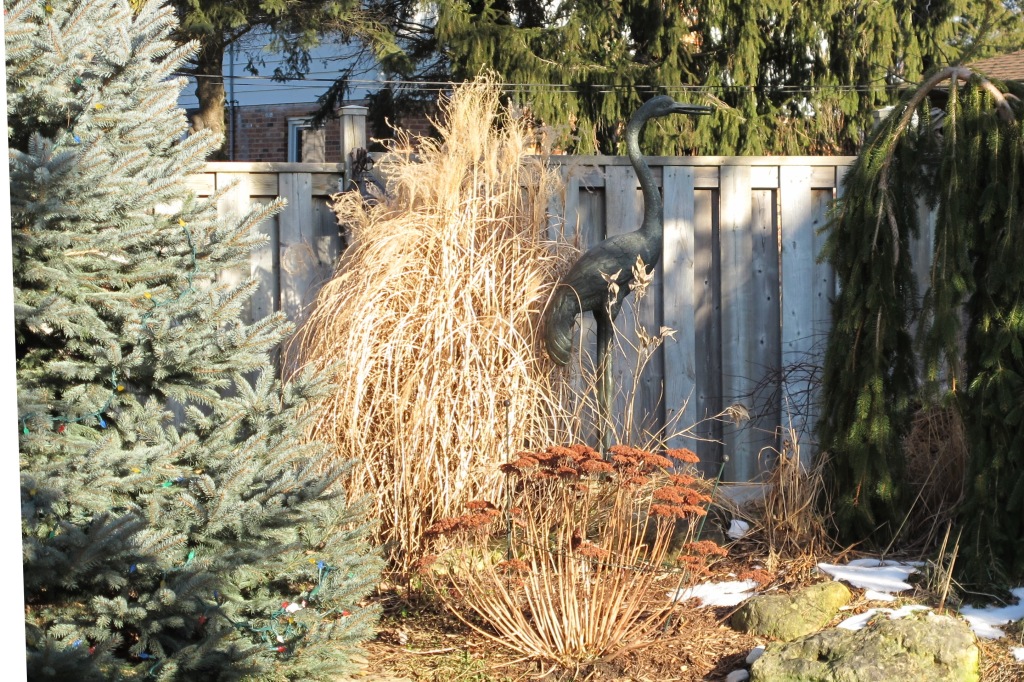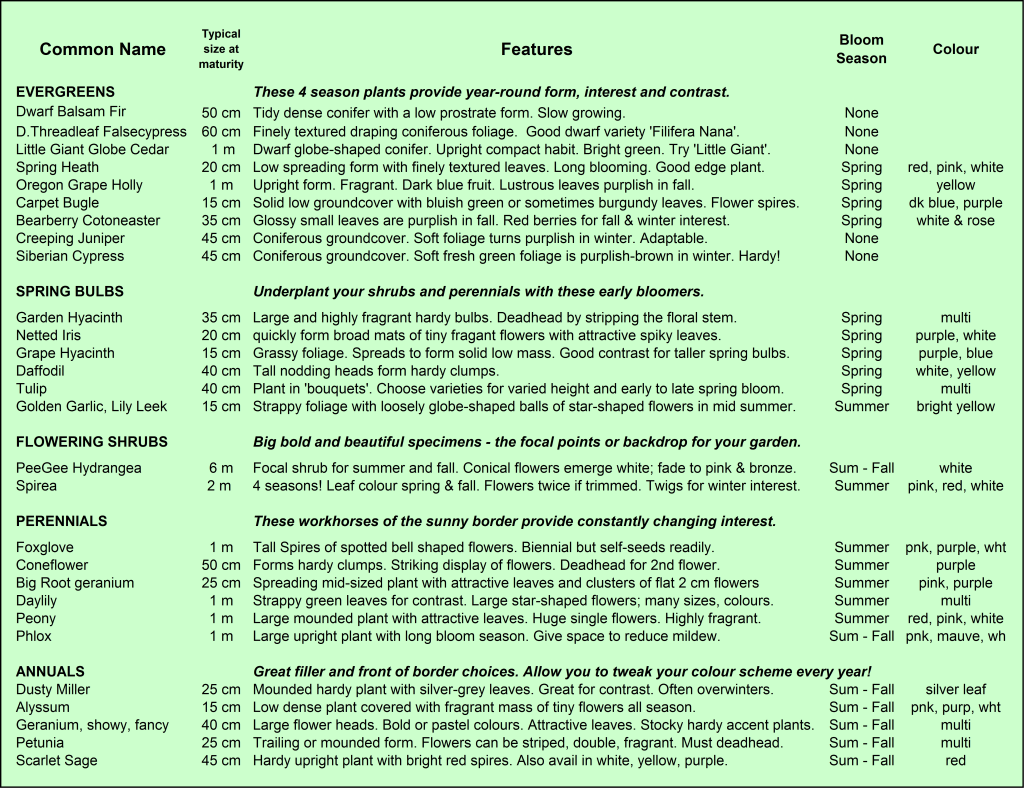
TEN TIPS to Creating Year-Round Interest!
1. Make the bed WIDE! Narrow garden beds rarely look good. Year-round interest requires more space. Typically you’ll need a minimum depth of 4 feet to give space for enough plants to create continuous bloom. Use a rough scale of 3:1, figuring on one foot of depth for every three feet of length. Hint – try laying out the shape in your yard with a garden hose. Choose a well-drained spot, ideally one that receives mid-day sun of 4-6 hours or more.
2. Give your garden good ‘bones’. For year-round interest, your garden’s structure needs backbone shrubs and possibly hardscapes such as large rocks, an arch or a bench. In winter, the branches, bark, berries, and evergreens will give shape and contrast to your garden against a backdrop of white snow. Include at least one coniferous or broadleaf evergreen such as Dwarf Balsam Fir or Bearberry Cotoneaster as well as some upright branches and twigs such as those of Spirea or Hydrangea.
3. Contrasting foliage and textures are as important as floral colour. Try for variety in the shape and size of leaves as well as the plant shape. For example, a nice combination would be the upright form of Garden Phlox Phlox paniculata, the rounded shape of Peony Paeonia lactiflora, the grass-like foliage of Daylilies Hemerocallis, and the spire-like flowers of Scarlet Sage Salvia splendens.
4. Create a layered look. Select a variety of plant heights – roughly an equal mix of short, medium and tall varieties. Swaths and groupings that repeat throughout the bed will make the best impression. Hint – most perennials will tolerate being moved in future but shrubs will resist. As your largest and most permanent elements, shrub selection and placement is the most critical.
5. Keep it simple and unified – Less is often more! Start with 3 main colour choices and don’t overdo the variety of plant materials. Hint – whites will glow even on dull days and in the evenings.
6. Choose plants for your hardiness zone. You’ll be rewarded with less work and better-looking plants. The ones listed in this article are suitable for a range of hardiness and your local nursery will usually stock varieties that are appropriate for your area.
7. Calculate the required number of plants for the size of your bed. Hint – Think about the mature size and avoid future blocked paths and obstructed windows! It will take up to 4 years for perennials to reach their full size. Fill in with annuals until they grow up.
- Number of varieties – The average perennial blooms for 3 weeks. To ensure a few varieties are in bloom at the same time, even a small bed needs a minimum of 12 different varieties. Hint – consider three as the minimum quantity of each annual or perennial variety.
- Total quantity of plants – Rule of thumb is 1 perennial for every 50 sq cm (1.5 square ft) of space. Use 2 square feet if you prefer more separation between plants. Some plant choices, such as Garden Phlox, will be healthier with ‘breathing’ space so try not to crowd them.
- Quantity for each season – Divide the total quantity by 3 to ensure you have bloom in every season.
8. Draw it out on paper. After researching your plant selections online, at the library and at the local garden centre, sketch a rough model of what you want to plant in what general location based on height, bloom and colour. Generally plan to place Tall specimens at the back, Groundcovers near the front or along the edge of paths, and shrubs and larger focal plants either centered in a small bed or interspersed in a larger one. With this to guide you, planting day will be easier and you’ll likely need to move fewer plants in the future! Hint – only very formal gardens require symmetry so don’t try to match and line things up too perfectly!
9. Buy from your list! Don’t get carried away by what’s in bloom in the garden centre that day.
10. Encourage continuous bloom. Deadhead regularly and feed with a balanced fertilizer every 3-5 weeks.
For Inspiration and detailed advice, explore resources such as these:
- What Grows When in Canadian Gardens, 1st ed. Trevor Cole, Dorling Kindersley Ltd, 2005
- Plant Hardiness Zones in Canada planthardiness.gc.ca/ph_main.pl?lang=en
- Attribute, Colour, Bloom time, Care etc perennials.com/index.html
- Plant Guide. Long blooming perennials bordine.com/
- Plant Selector – Search for Plants by attributes hort.uconn.edu/plants/
- Great Plant Picks greatplantpicks.org/
Your choices of plant material are almost limitless but should always reflect your own preference. You’ll want a garden that’s compatible in style with you and your home!
With a little planning you can create a border garden that will have continuous bloom for enjoyment year round. Winter is a terrific time to read and explore plant choices. Start making your list and in no time you’ll be ready for spring.
Happy Gardening! Linda Armstrong, London Middlesex Master Gardeners
To get you started, here’s a list of potential plant choices for Canadian zone 5/6





About The Author: Armstrong
As an author and editor, Linda directs her lifelong love of nature and plants to concerns about our environment and how we can do better. In addition to decades of gardening experience, and training as a master gardener, Linda focuses on learning from leading science-based educators and writers, and in the process finds that she uncovers many gardening myths.
More posts by Armstrong